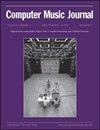聆听人类世:一个问题
IF 0.4
Q4 COMPUTER SCIENCE, INTERDISCIPLINARY APPLICATIONS
引用次数: 0
摘要
摘要本文讨论了与Soundlapse项目相关的声音装置和动感雕塑A Queda do Céu的算法设计和实现。在其中,我们概述了该项目,并继续描述了与安装相关的主要计算挑战,其中包括各种实时处理、插值和映射算法。我们将这项工作与区域生态和政治辩论以及全球气候危机联系起来。在这样做的过程中,我们呼应了其他录音和现场录音艺术家的观点,他们认为艺术品作为实验场具有重要作用,在这里可以探索新的技术应用,并可以研究、重新配置和运用新的聆听模式。最后,我们概述了Soundlapse项目目前正在解决的挑战,特别是开发一种改进版的声波延时方法,该方法结合了机器学习例程和用户定义的空间化功能。本文章由计算机程序翻译,如有差异,请以英文原文为准。
Listening to the Anthropocene: A Queda do Céu
Abstract This article discusses the algorithmic design and implementation of A Queda do Céu, a sound installation and kinetic sculpture related to the Soundlapse project. In it we provide an overview of the project and go on to describe the main computational challenges related to the installation, which included a variety of real-time processing, interpolation, and mapping algorithms. We contextualize the work in relation to regional ecological and political debates, as well as the global climate crisis. In doing so, we echo other sound and field-recording artists in proposing that artworks have an important function as experimental arenas in which new technological applications can be probed and where new modes of listening can be investigated, reconfigured, and exercised. In closing, we lay out an overview of the current challenges being tackled by the Soundlapse project, specifically the development of a refined version of the sonic time-lapse method that incorporates machine learning routines and user-defined spatialization capabilities.
求助全文
通过发布文献求助,成功后即可免费获取论文全文。
去求助
来源期刊

Computer Music Journal
工程技术-计算机:跨学科应用
CiteScore
1.80
自引率
0.00%
发文量
2
审稿时长
>12 weeks
期刊介绍:
Computer Music Journal is published quarterly with an annual sound and video anthology containing curated music¹. For four decades, it has been the leading publication about computer music, concentrating fully on digital sound technology and all musical applications of computers. This makes it an essential resource for musicians, composers, scientists, engineers, computer enthusiasts, and anyone exploring the wonders of computer-generated sound.
Edited by experts in the field and featuring an international advisory board of eminent computer musicians, issues typically include:
In-depth articles on cutting-edge research and developments in technology, methods, and aesthetics of computer music
Reports on products of interest, such as new audio and MIDI software and hardware
Interviews with leading composers of computer music
Announcements of and reports on conferences and courses in the United States and abroad
Publication, event, and recording reviews
Tutorials, letters, and editorials
Numerous graphics, photographs, scores, algorithms, and other illustrations.
 求助内容:
求助内容: 应助结果提醒方式:
应助结果提醒方式:


